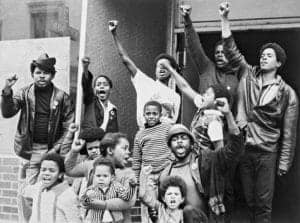A study of the manpower implications of small business financing
by Joseph Debro
A 1968 book-length report, titled “A Study of the Manpower Implications of Small Business Financing: A Survey of 149 Minority and 202 Anglo-Owned Small Businesses in Oakland, California,” was sent to the Bay View by its author, Joseph Debro, prior to his death in November 2013, and his family has kindly permitted the Bay View to publish it. The survey it’s based on was conducted by the Oakland Small Business Development Center, which Debro headed, “in cooperation with the small businessmen of Oakland, supported in part by a grant, No. 91-05-67-29, from the U.S. Department of Labor, Manpower Administration, Office of Manpower, Policy, Evaluation and Research.” Project co-directors were Jack Brown and Joseph Debro, and survey coordinator was Agustin Jimenez. The Bay View is publishing the report as a series. A prolog appeared in the December 2013 Bay View, Part 1 in January 2014, Part 2 in February 2014, Part 3 in April 2014, Part 4 in May 2014, Part 5 in June 2014, Part 6 in August 2014, Part 7 in October 2014, Part 8 in November 2014, Part 9 in January 2015, Part 10 in March 2015, Part 11 in May 2015, Part 12 in October 2015, Part 13 in December 2015, Part 14 in May 2016, Part 15 in February 2017, Part 16 in March 2017 and this is Part 17 of the report.

Labor-management views of minority employment (continued)
Federation B was considerably more liberal than Federation A in terms of admitting Negroes, but colored workers were largely restricted to two of the 42 locals. There were 2,000 Negroes (of a total of 15,000 members) in the longshoremen’s and warehousemen’s unions, and 2,500 of 7,000 total involved in marine cooks’ and stewards’ unions.
Stripp’s conclusions are quite germaine to our own study. Briefly, they are:
- Officers representing Federation A did not often express apology for or regret of not having Negroes number among their ranks, although they insisted that their unions did not discriminate. On the other hand, officers of Federation B regretted not having made more progress in anti-discrimination efforts.
- Officers of both federations observed that Negroes were handicapped by lack of special skills and education.
- In both federations, leaders claimed that the biggest block to Negro advancement in labor was initial acceptance.
- The NAACP and the Urban League were able to place Negroes in jobs and unions where entry would have been impossible when attempted solely by individual colored workers.
- Most significant numerical gains for Negroes in labor unions were in those fields traditionally associated with Blacks in other parts of the country: construction labor, building, laundry and culinary services. More headway was made in shipbuilding and repair, along with shipyard and shop labor. Entry began in boilermaker and machinists’ unions and street transportation as well as for railroad workers, carpenters and printers.
- Those areas still closed to Negroes were teamstering, professional, technical and white collar jobs, and several craft unions associated with Federation A.
- Union leaders of both federations unanimously attributed most of the job discrimination to management.
- Compared with his former status in both federations, the Negro was in a relatively more favorable position with regard to labor.
By 1956, Babow and Howden had noticed some positive changes, but very few significant breakthroughs had occurred. Their study lent credence to Stripp’s findings that job discrimination is, perhaps, more a function of Anglo employer attitude than Anglo worker attitudes. However, historical data presented in sections I and II of this paper would indicate that both labor and management share culpability. These authors summarized union practices as of 1956 as follows (1958:184-5):
“1. In certain industries (e.g., one service industry firm and another in communications), the union plays quite a minor role in hiring and upgrading.
“2. The employers will not accept non-discrimination clauses in their labor contracts despite strong union insistence.
“3. Some of the employers the union deals with have indicated they will not accept nonwhite workers for certain jobs. In other cases, employers do not communicate such a restrictive policy but do not hire nonwhites if they are referred by the union.
“4. Relatively few non-whites with the required skills have applied, and although they would be welcomed on an equal basis in the labor organizations, it might still be difficult for them to be placed.
“5. Non-whites are often discouraged from getting the special training they need, or feel little incentive to do so, if in past years few nonwhites have been able to obtain employment in the given field and there has been no public indication that these employers are now practicing merit employment.”
Babow and Howden’s study confirmed the time-tested, common sense view that employers, not trade unions are the principal determinants in hiring, upgrading and termination of employees. Employers are aided in their efforts to seek personnel by private and public placement agencies. Private placement agencies depend heavily upon the whims of the employer. If an employer wishes to discriminate and conveys this information to the agency, the agency must also exercise discrimination or go under. The state Department of Employment and college placement services are up against the same wall.
Most employers claimed to have a non-discriminatory merit employment policy, but Babow and Howden found that the policy was “so vague, so lacking in formulation, implementation, or communication within the firm or to its labor sources, so much a matter of option to department or division chiefs, or so uneven in application to various job levels and categories, that the term ‘policy’ seemed almost devoid of meaning” (1958: 307). The “hire the best man possible for the job” policy was often contradicted by representatives of management within the interview. Many respondents revealed negative stereotyped views of minority persons, while seeming to ignore individual variations. Most of these negative remarks were aimed at Negroes, and Latin Americans (mainly Mexicans) and, to a lesser extent, against Orientals and Jews.
Salient reasons given by employers for not hiring minority persons were: acknowledged fears of customer or employee objections to their employment, the fact that department or division chiefs were free to discriminate in personnel practices, the absence of minority job applicants when suitable jobs were available, the lack of skills or experience on the part of minority applicants. These, coupled with the practices mentioned previously, effectively eliminate minority persons from the economically mobile jobs.
If a minority employee were hired, an invisible but very real ceiling would exist, above which he could not climb, according to the findings of these two authors. In sum, the studies of Stripp and Babow and Howden both indicate that those same processes which were operative at the national level are also present in the Bay Area to keep minority employees out of work or in the lowest socio-economic categories of employment.
Public assistance
Correlated highly with low income in the Target Areas of Oakland is the large number of persons dependent upon public assistance. Table X provides us with a view of the Oakland census tracts broken down by income level and total numbers of public assistance cases. Welfare categories included are: Old Age Assistance, Aid to the Blind, Aid to Families with Dependent Children (one parent absent or incapacitated), Aid to Families with Dependent Children (father unemployed), Children in Boarding Homes and Institutions, Aid to Disabled, Medical Assistance to the Aged, and General Assistance or County Aid.
In 1966, the Target Areas accounted for 85 percent of Oakland’s case load for General Assistance, 79 percent AFDC, 79 percent for Aid to the Disabled, 63 percent for Aid to the Blind, 53 percent of Old Age Assistance and 46 percent of the case load for Medical Assistance to the Aged (Department of Human Resources, 1964:5-6; “Profile of Target Areas for the Economic Opportunity Program”).
Most of the categories of public assistance are designed for persons of ill health, the aged or infirm. Their presence in large proportions in the Target Areas is a further demonstration of the pitiable conditions of poverty spread over such a large extent of Oakland. Poverty is also correlated with the debilitating diseases such as tuberculosis and syphilis, to mention but two. Approximately 68 percent of the active tuberculosis cases and 75 percent of the syphilis cases are found in the Target Areas (DHR, 1964:5).
Joseph Debro, born Nov. 27, 1928, in Jackson, Miss., and a pillar of Oakland until his death on Nov. 5, 2013, was president of Bay Area Black Builders and of Transbay Builders, a general engineering contractor, former director of the Oakland Small Business Development Center and the California Office of Small Business, co-founder of the National Association of Minority Contractors and a bio-chemical engineer.





